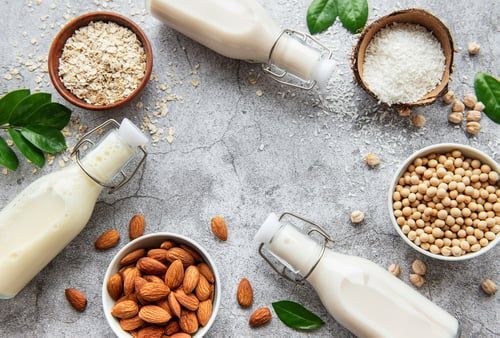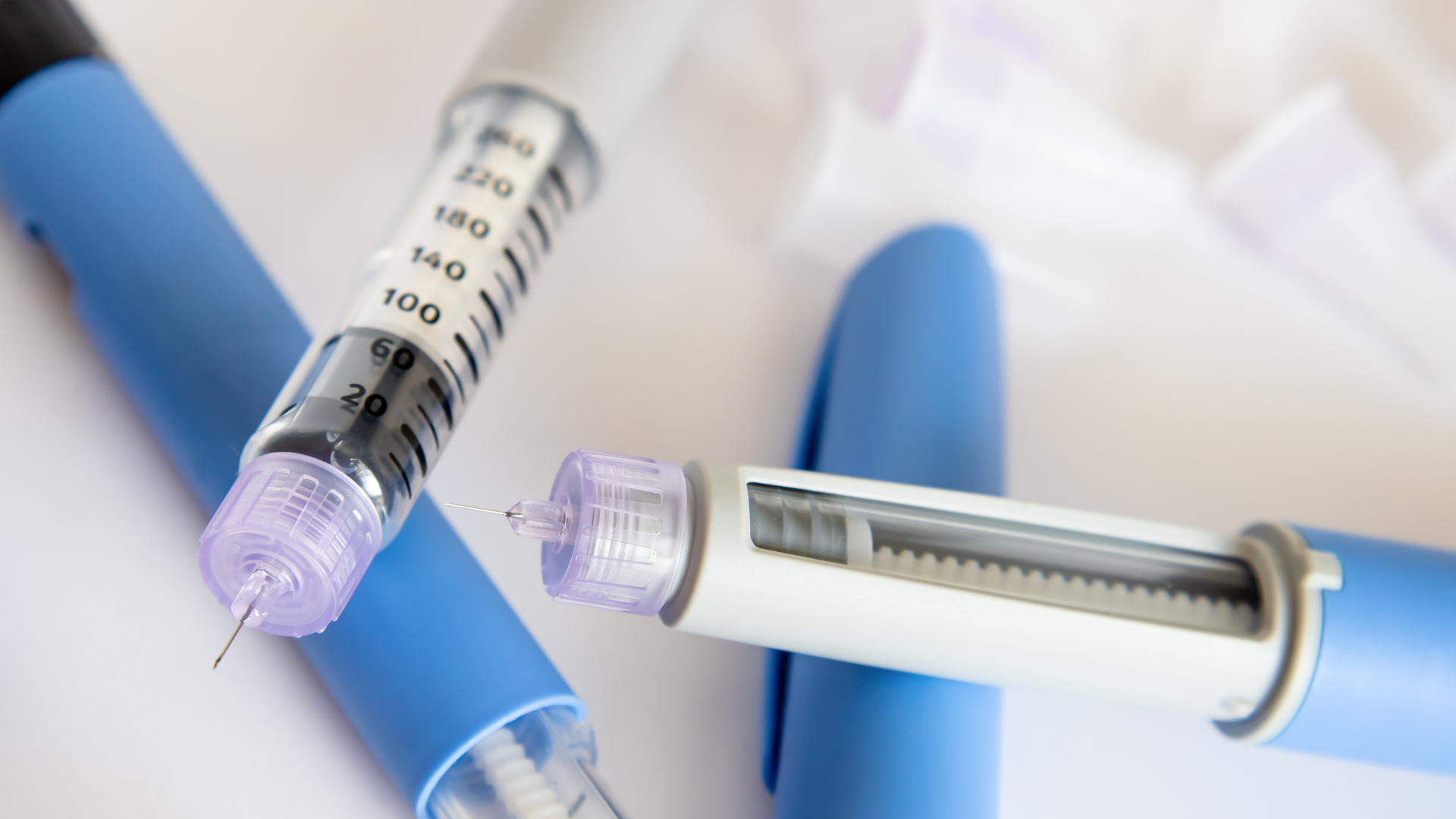Which Milk Is Best For People With Diabetes?
Over the last few years, the variety of milk products has grown substantially. Cow’s milk, lactose-free milk, almond milk, oat milk – the list goes on. So how do you know which one to choose?
It used to be simple. There was cow’s milk and a lactose-free alternative, like soy or almond milk. However, the offerings have multiplied due to the demand for plant-based milk products.
The milk section at the grocery store is loaded with choices and may set your head spinning. Should you choose skim or whole milk? Is there a benefit to choosing plant-based milk? Are there some milk options that are better for people with diabetes?

What is milk?
Milk is a beverage generally defined as a liquid that sustains young mammals. Because it is the sole food for the development and growth of babies, it’s packed with nutrients like protein, fat, and calcium.
In the U.S., most people think of milk as cow’s milk. But around the world, sheep and goat’s milk are also common.
While milk is an excellent source of vitamins and minerals, not everyone can tolerate it. Some people may be lactose intolerant, which is the inability to properly digest the carbohydrates in milk (lactose). Those who are lactose intolerant may experience gas, bloating, and diarrhea if they consume cow’s milk.
Milk allergies, which are less common, is an allergy to the protein in milk. Symptoms of milk allergies are usually different than lactose intolerance, ranging from mild skin irritation or hives to more severe anaphylaxis.
You may also prefer a vegan or vegetarian alternative. Plant-based products like soy, almond, and oat milk are beverages that have a similar color and texture to milk but are made with plants and water. They often can be used as an alternative to cow’s milk in recipes.
What are the health benefits of drinking milk?
Current dietary guidelines for Americans recommend three servings of dairy every day. This includes milk, yogurt, and cheese. Besides the fact that milk is an excellent way to get a combination of carbohydrates, fat, and protein, it has several other health benefits.
For example whey, a protein found in cow’s milk, may have what Jess DeGore, a registered dietitian and certified diabetes care and education specialist, called “insulinotropic” effects. This means whey protein could stimulate the production and activity of insulin. This is especially important for someone with insulin resistance.
“Experimental studies indicated that whey protein has glucose-lowering properties,” said DeGore. ““Cow’s milk is my first recommendation as many of the plant-based milks have a less diverse nutritional profile.”
More research is needed, but some studies suggest low-fat cow’s milk may be linked to a reduce risk for type 2 diabetes. Low-fat dairy products could also be beneficial for other health conditions including cardiovascular disease, stroke, hypertension, colorectal cancer, metabolic syndrome, obesity, and osteoporosis.
Dairy milk
Take a quick stroll through the dairy section of the supermarket and you’ll see the large variety of milk available. Besides yogurt, cheese, and butter, there are rows and rows of milk. Here’s an overview of the different types you’ll find and the nutrient value of each kind.
Cow’s milk
Cow’s milk is hard to beat nutritionally. It’s an excellent source of bone-building calcium and vitamin D. You can get several different kinds of cow’s milk, including low-fat (skim, 1%, or 2%), whole, organic, or ultra-filtered.
Whole milk
Nutrition information for one cup:
Calories: 149 kcals, Protein: 8 grams, Fat: 8 grams, Carbs: 12 grams, Sugar: 12 grams, Sodium: 105 mg, Calcium: 276 mg, Vitamin D: 3.17 mcg
“I recommend whole milk whenever there's no concern about dairy allergies,” said registered dietitian Kara Harbstreet. “Whole milk is the least processed and most nutrient-dense of traditional dairy options. The fat and protein content can help stabilize blood glucose levels and prevent rapid absorption of the carbohydrates naturally found in milk.”
Low-fat milk
Nutrition information for one cup:
Calories: 84-122 kcals, Protein: 8 grams, Fat: 0-5 grams, Carbs: 12 grams, Sugar: 12 grams, Sodium: 96 mg, Calcium: 310 mg, Vitamin D: 2.6-2.7 mcg
With low-fat milk, some of the cream is removed to lower fat content. As a result, the calorie count is a bit lower than whole milk.
Two well-researched diet patterns, the Mediterranean and DASH diets, include consumption of low-fat dairy. These diet patterns have repeatedly shown numerous health benefits, such as diabetes prevention, decreased cardiovascular disease, and reduced non-alcoholic fatty liver disease.
Ultra-filtered
Nutrition information for one cup:
Calories: 120 kcals, Protein: 13 grams, Fat: 4.5 grams, Carbs: 6 grams, Sugar: 6 grams, Sodium: 120 mg, Calcium: 401 mg, Vitamin D: 5 mcg
Ultra-filtered milk has been specially filtered so that there is more protein and calcium and less sugar than conventional milk.
That means that ultra-filtered milk has half the carbs. So if you are looking to reduce your carbs and up your protein, this might be a great way to do it. In addition, the filtration process removes the lactose, so even those with lactose intolerance may be able to drink it.
Lactose-free milk
Nutrition information for one cup:
Calories: 90-160 kcals, Protein: 8 grams, Fat: 0-8 grams, Carbs: 12 grams, Sugar: 12 grams, Sodium: 125 mg, Calcium: 300-310 mg, Vitamin D: 2.5 mcg
Certain milk brands, such as Lactaid, have added the enzyme lactase to the milk. Lactase breaks down lactose so it is more easily digested.
It has the same protein and fat content as regular cow’s milk, as well as vitamins and minerals. Lactose-free milk is an excellent option for those looking for the nutritional value of milk but who are lactose-intolerant.
Goat milk
Nutrition information for one cup:
Calories: 168 kcals, Protein: 9 grams, Fat: 10 grams, Carbs: 11 grams, Sugar: 11 grams, Sodium: 122 mg, Calcium: 327 mg, Vitamin D: 3.1 mcg
Another option in the dairy aisle is goat milk. With a different taste than cow’s milk, goat milk may be easier for some to digest. Goat milk is higher in oligosaccharides (the same carbohydrate present in nutrient-rich breastmilk) than cow’s milk.
These oligosaccharides possess anti-inflammatory properties and serve as fuel for healthy gut bacteria. Like cow’s milk, goat milk is high in calcium, the mineral essential for bone health.
Organic
When the label states that milk is organic, it means the animal was raised with certain methods of farming. Those methods include the restriction of pesticides, fertilizers, and GMO products used for their food and there were no antibiotics or hormones used to increase milk production.
The cows or goats are allowed to graze more freely and are pastured for at least one-third of the year. Organic farming is thought to be more humane. However, there is little difference from a nutrition standpoint.
Plant-based milk

For those following a vegetarian or vegan diet, there is a vast amount of plant-based options. So which one is best?
“Look for a plant-based milk with a higher protein and fat content whenever possible,” Harbstreet said.
When compared to cow’s milk, plant-based milk is often lower in phosphorus, a mineral that needs to be limited in those with kidney disease. Here’s a list of some common plant-based milks you’ll find at the grocery store.
Oat milk
Nutrition information for one cup:
Calories: 90 kcals, Protein: 2 grams, Fat: 1.5 grams, Carbs: 19 grams, Sugar: 4 grams, Sodium: 120 mg, Calcium: 350 mg, Vitamin D: 4 mcg
Oat milk is made by combining oats with water. The mixture is then strained and the result is a creamy beverage. You can even make your own at home. In addition to being plant-based, oat milk is also nut-free. Oat milk may be a preferable option for those with nut allergies.
You’ll notice the carb counts are a bit higher with oat milk than the other types of milk. However, unlike most milk, oat milk contains 2-3 grams of fiber per serving. This soluble fiber – beta-glucan – improves post-meal blood glucose.
Almond milk
Nutrition information for one cup:
Calories: 60 kcals, Protein: 1 gram, Fat: 2.5 grams, Carbs: 8 grams, Sugar: 7 grams, Sodium: 150 mg, Calcium: 470 mg, Vitamin D: 2 mcg
A very popular plant-based beverage, almond milk has a nutty flavor and similar texture to cow’s milk. Almond milk is made with almonds and water.
Because it is low in carbohydrates, it may be a good option if you are looking to reduce carbs. Almond milk is also a good source of vitamin E, which has antioxidant and anti-inflammatory properties.
Keep in mind that as with other plant-based milk products, some almond milk brands contain extra sugar and calories; it’s important to read nutrition labels to ensure you’re buying the product right for your dietary needs.
Soy milk
Nutrition information for one cup:
Calories: 100 kcals, Protein: 8 grams, Fat: 4.5 grams, Carbs: 9 grams, Sugar: 6 grams, Sodium: 90 mg, Calcium: 450 mg, Vitamin D: 3 mcg
Soy milk comes pretty close to dairy in its nutrition profile. It’s got protein, fat, carbs, calcium, and vitamin D. Made by blending soybeans and water, soy milk is a widely available plant-based beverage.
Rich in isoflavones and phytochemicals (plant antioxidants), soy milk has been found to lower triglycerides, total cholesterol, and LDL or “bad” cholesterol.
Coconut milk
Nutrition information for one cup:
Calories: 70 kcals, Protein: 0 grams, Fat: 4.5 grams, Carbs: 8 grams, Sugar: 7 grams, Sodium: 30 mg, Calcium: 130 mg, Vitamin D: 2.5 mcg
Coconut milk has a rich and slightly sweet coconut flavor. It is notably low in protein but does contain carbohydrates and fat.
The dietary fat in coconut milk – medium chain triglycerides – has some potential health benefits. For instance, MCTs may increase calorie burn and are highly satiating, which may prevent overeating.
Rice milk
Nutrition information for one cup:
Calories: 120 kcals, Protein: 0 grams, Fat: 2.5 grams, Carbs: 24 grams, Sugar: 11 grams, Sodium: 80 mg, Calcium: 20 mg, Vitamin D: 0 mcg
With higher carbs than most other types of milk, rice milk has zero protein, vitamin D, and little calcium. Because of this, rice milk may not be the ideal option for someone with diabetes. However, rice milk is generally well tolerated by those who have food allergies.
Hemp milk
Nutrition information for one cup:
Calories: 60 kcals, Protein: 3 grams, Fat: 4.5 grams, Carbs: 0 grams, Sugar: 0 grams, Sodium: 110 mg, Calcium: 260 mg, Vitamin D: 2 mcg
Made from whole hemp seeds, hemp milk is another vegan alternative that is low in carbs. Although it is made from the cannabis plant – the same plant from which marijuana is derived – hemp seeds do not have the same mind-altering effects.
Hemp seeds are a good source of omega-3 and omega-6 fatty acids. Hemp milk is gluten, dairy, and soy-free and may be an option for those with allergies and intolerances to those ingredients.
Cashew milk
Nutrition information for one cup:
Calories: 25 kcals, Protein: 1 gram, Fat: 2 grams, Carbs: 1 gram, Sugar: 0 grams, Sodium: 160 mg, Calcium: 470 mg, Vitamin D: 2 mcg
Like other nut milk varieties, cashew milk is composed of cashews and water and can be made at home. It has a sweet and creamy flavor, similar to almond milk.
Cashew milk is one of the lowest in calories and carbohydrates. Cashew milk is fortified to contain calcium and vitamin D, and is a natural source of vitamin E.
Flax milk
Nutrition information for one cup:
Calories: 25 kcals, Protein: 0 grams, Fat: 2.5 grams, Carbs: 1 grams, Sugar: 0 grams, Sodium: 85 mg, Calcium: 270 mg, Vitamin D: 2.2 mcg
Flax milk is made from flaxseeds and water. Like hemp seeds, flaxseeds are also rich in omega-3 and omega-6 fatty acids. Dietary flaxseed has been shown to reduce blood pressure and cholesterol and has anti-inflammatory properties.
Although it has a nutty flavor and is creamy like almond milk, it is nut-free. In addition, flax milk is a gluten-free and dairy-free beverage that is very low in calories and carbohydrates.
Tips for choosing diabetes-friendly milk
Everyone has their own preferences, budget, and unique set of dietary needs. There are several things to consider when choosing the right milk for you.
- Consider the whole picture: The scope of your overall diet is much more than one serving of milk. “Are you consuming the milk in cereal? With dessert? With a balanced dinner?” DeGore said. “The vitamins A, D, E, and K are fat soluble so need fat for optimal absorption. If choosing a higher-fat milk or dairy product can lead to less consumption of added sugars then it can be a better option.”
- Watch for added sugar: “Know that flavored milk (like chocolate, strawberry, and vanilla) will have added sugar, which needs to be accounted for if dosing insulin or adjusting medications,” said Harbstreet.
- Look at the label: You can learn a lot about the product by looking at the nutrition label. If you’re looking to avoid added sugar or for a lower-fat product, for example, assessing the nutrition label is a good place to start.
- What nutrients do you need? Each type of milk has its own nutritional profile. If you are in need of more protein, cow’s milk or ultra-filtered milk may be the right choice. Likewise, if you need calcium and vitamin D, choose one of the beverages that have been fortified.
- Be aware of additives: Ingredients like thickeners and carrageenan (a food preservative) are often added to milk beverages so that they are more like cow’s milk. While these additives are generally recognized as safe by the FDA, some studies suggest that limiting exposure to such ingredients.
The bottom line
The milk you choose is completely up to your personal preferences and health needs. While dairy milk has a superior nutrition profile when compared to plant-based milk, not everyone prefers dairy. The good news is that there is an option for everyone.
Credited: [Author: Erin Davis], [Source: diaTribe Learn MAKING SENSE OF DIABETES], [Site: https://diatribe.org/]
Healthy Bites















